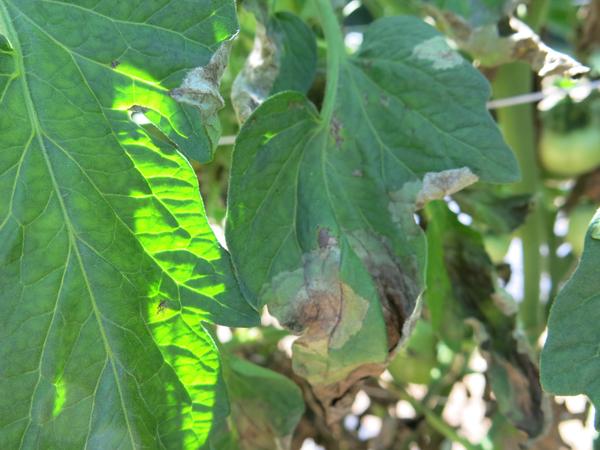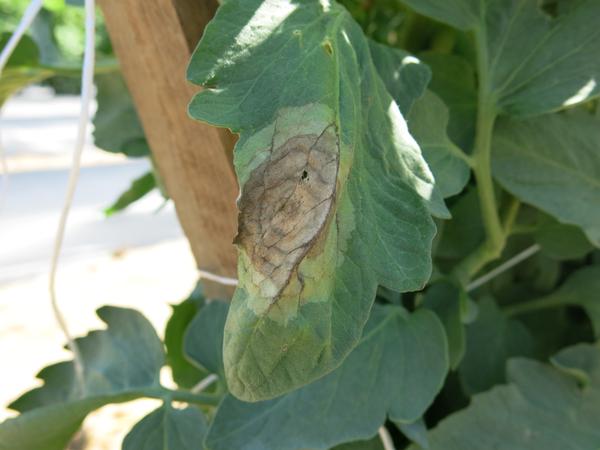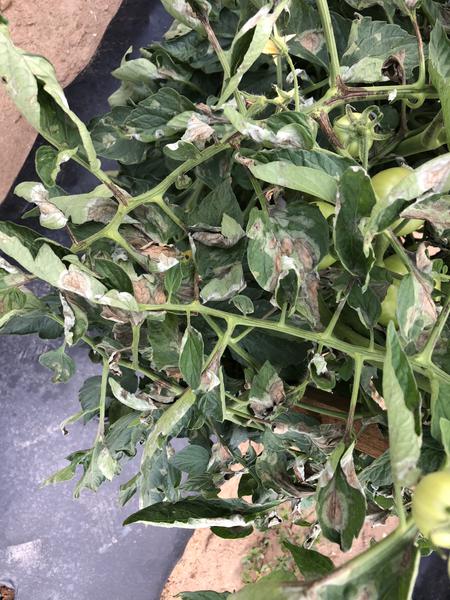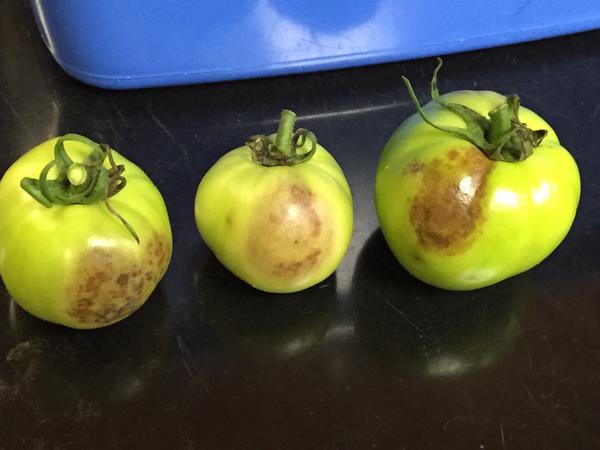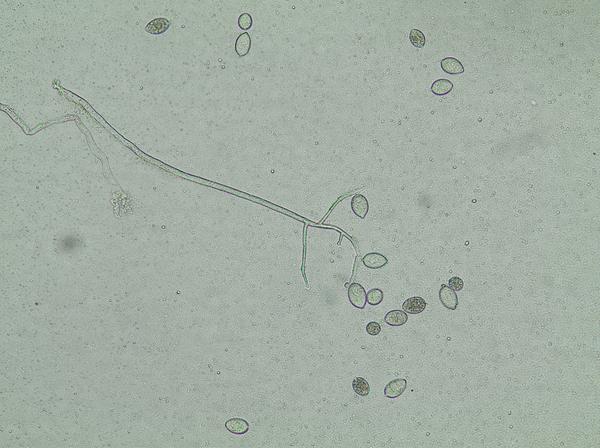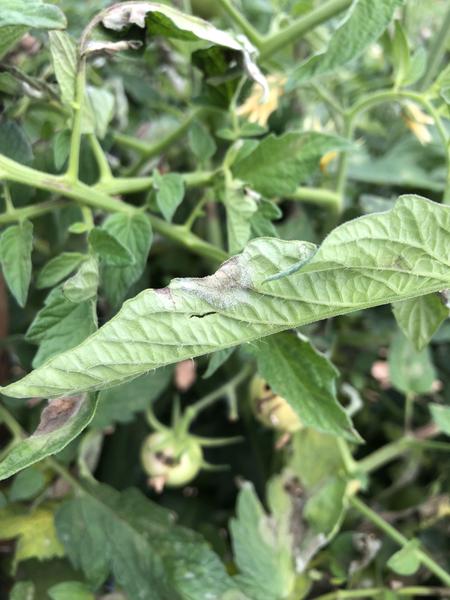Pathogen
Tomato late blight is caused by the oomycete pathogen Phytophthora infestans (P. infestans). The pathogen is best known for causing the devastating Irish potato famine of the 1840s, which killed over a million people, and caused another million to leave the country.
Host Crops and Plants
Solanaceous plants such as potato, tomato, petunia and nightshade, but the disease is economically important mainly in potato and tomato.
Host Parts Affected
All above-ground portions of the plant, but the disease is usually first recognized by its foliar symptoms.
Identification
The first symptoms of late blight on tomato leaves are irregularly shaped, water-soaked lesions, often with a lighter halo or ring around them (Figure 1); these lesions are typically found on the younger, more succulent leaves in the top portion of the plant canopy. During high humidity, white cottony growth may be visible on underside of the leaf (Figure 2), where sporangia form (Figure 3 and Figure 5). Spots are visible on both sides of the leaves. As the disease progresses, lesions enlarge causing leaves to brown, shrivel and die. Late blight can also attack tomato fruit in all stages of development. Rotted fruit are typically firm with greasy spots that eventually become leathery and chocolate brown in color (Figure 4); these spots can enlarge to the point of encompassing the entire fruit.
"Look alike" diseases: Other species of Phytophthora, specifically P. nicotianae and P. capsici, can also cause lesions on tomato and tomato fruit similar to those caused by late blight. However, these two species are soilborne (as opposed to ariborne) and typically only cause disease after the plants have been flooeded or if the plant had been in contact with wet soil.
Late blight can be differentiated from early blight on tomato and other foliar fungal diseases by where they occur on the plant. Lesions caused by late blight can be found anywhere on the plant, but are mostly found on the new growth whereas early blight typically starts on the lower leaves and slowly moves up the plant. Also, lesions caused by late blight tend to be light brown or tan in color while lesions caused by early blight tend to be dark brown in color with concentric rings.
View this brief video to help you diagnose late blight!
Favorable Environmental Conditions for the Disease
The pathogen is favored by cool, wet weather; clouds protect the spores from exposure to UV radiation by the sun, and wet conditions allow the spores to infect when they land on leaves. Nights in the 50s / 60s and days in the 80s accompanied by rain, fog or heavy dew are ideal for late blight infection. Under these conditions, lesions may appear on leaves within 3-5 days of infection, followed by white cottony growth soon thereafter (Figure 2). This white cottony growth is a sign of rampant spore production. Although spores may also be produced on tomato fruit, they are more commonly produced on leaves. Spores can spread readily by irrigation, equipment, wind and rain and can be blown into neighboring fields within 5-10 miles or more, thus beginning another cycle of disease.
General Disease Management
- Plant early in the season to escape high disease pressure later in the season
- Do not allow water to remain on leaves for long periods of time
- Scout plants often and remove infected plants, infected fruit, volunteers and weeds
- Sign up to recieve alerts at the USAblight website
- Plant resistant varieties when possible.
- Protect the crop with fungicides
| Fruit Type | Late Blight Resistant Variety |
|---|---|
| Round | Defiant PhR |
| Legend | |
| Mountain Gem | |
| Mountain Merit | |
| Mountain Rouge | |
| Plum/Roma | Plum Regal |
| Grape and cherry | Golden Sweet (yellow grape) |
| Lizzano (cherry) | |
| Matts Wild Cherry (heirloom cherry) | |
| Mountain Magic (large cherry/campari) | |
| Mountain Honey (grape) | |
| Red Grape (grape) | |
| Red Pearl (grape) | |
| Toronjina (cherry) |
Disease Control for Conventional Growers
Before disease occurs, apply fungicides at 7-10 day intervals. After disease is detected in your area, apply fungicides at 5-7 day intervals. Alternate products and tank mix with chlorothalonil to avoid generating fungicide-resistant strains. For the latest fungicide recommendations for tomato late blight see the Southeastern US Vegetable Crop Handbook. Fungicide labels are legal documents, always read and follow fungicide labels.
Example products for tomato late blight control:
| Active ingredient | Example product | PHI (day) | Group |
|---|---|---|---|
| Fluopicolide | Presidio 4FL | 2 | 43 |
| Oxathiapiprolin + chlorothalonil | Orondis Opti | 0 | 49 + M |
| Oxathiapiprolin + mandidpropamid | Orondis Ultra | 1 | 49 + 40 |
| Propamocarb | Previcur Flex | 14 | 28 |
| Cyazofamid | Ranman 3.6SC | 0 | 21 |
| Ametoctradin + dimethomorph | Zampro | 4 | 45 + 40 |
| Mandipropamid + difenoconazole | Revus Top | 1 | 40 + 3 |
| Dimethomorph | Acrobat 50WP | 0 | 40 |
| Cymoxanil | Curzate 60DF | 14 | 27 |
| Mefenoxam + chlorothalonil | Ridomil Gold Bravo | 14 | 4 + M |
| Mancozeb + zoxamide | Gavel 75WG | 5 | 22 + M |
| Mancozeb | Dithane | 5 | M |
| Chlorothalonil | Bravo | 0 | M |
For example, before disease you can use: Acrobat + Bravo, or Curzate + Bravo, or Gavel, every 7 days in rotation. After disease you can use: Revus Top + Bravo, or Presidio + Bravo, or Ridomil Gold Bravo every 5 days in rotation.
Disease Control for Organic Growers
Organic growers have fewer chemical options that are effective; the only OMRI labeled active ingredients that have decent efficacy against late blight are fixed copper formulations. Organic growers should plant susceptible varieties early in the season or select a late blight resistant variety.
Disease Control for Home Gardeners
Products containing the active ingredients copper or chlorothalonil (the trade name of one product with chlorothalonil is known as ‘Daconil’) are the best and only effective products available to home gardeners. In addition, home gardeners should grow varieties with resistance if they are worried about late blight in future years because most chemicals available to the home gardener are not sufficient to control late blight once it appears. Once plants are infected in a home garden, there is little that can be done to protect them besides weekly fungicide sprays.
Home owners should plant susceptible varieties early in the season or select a late blight resistant variety.
Useful Resources
- The NC State University Plant Disease and Insect Clinic provides diagnostics and control recommendations
- USAblight provides forecasts and reports of disease outbreaks
- The NC State Extension Plant Pathology portal provides information on crop disease management
- The Southeastern US Vegetable Crop Handbook provides information on vegetable disease management
- The USDA Fungus-Host Distributions Database provides information about reported hosts for fungal and oomycete pathogens
Acknowledgements
This factsheet was prepared by the NC State University Vegetable Pathology Lab in 2014.
Publication date: Jan. 17, 2019
Revised: Jan. 9, 2023
Recommendations for the use of agricultural chemicals are included in this publication as a convenience to the reader. The use of brand names and any mention or listing of commercial products or services in this publication does not imply endorsement by NC State University or N.C. A&T State University nor discrimination against similar products or services not mentioned. Individuals who use agricultural chemicals are responsible for ensuring that the intended use complies with current regulations and conforms to the product label. Be sure to obtain current information about usage regulations and examine a current product label before applying any chemical. For assistance, contact your local N.C. Cooperative Extension county center.
N.C. Cooperative Extension prohibits discrimination and harassment regardless of age, color, disability, family and marital status, gender identity, national origin, political beliefs, race, religion, sex (including pregnancy), sexual orientation and veteran status.

